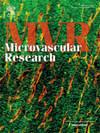Prognostic value of the wall-to-lumen ratio of retinal arteries in patients with end-stage chronic kidney disease
IF 2.7
4区 医学
Q2 PERIPHERAL VASCULAR DISEASE
引用次数: 0
Abstract
Purpose
To investigate the hypothesis that the wall-to-lumen ratio (WLR) of retinal arteries is predictive of morbidity and mortality in patients with end-stage chronic kidney disease (CKD).
Methods
Prospective single center clinical study. In 83 patients with CKD (average age (±SD) 75.8 (±11.4) years), arterial metrics in the retinal vasculature were measured using adaptive optics ophthalmoscopy (AOO; rtx1, ImagineEyes, France). Multivariate analysis including vascular metrics and biological parameters was done to identify predictive risk factors of the morbidity and mortality rates at 3 years.
Results
At inclusion, the mean (±SD) wall-to-lumen ratio (WLR) was 0,34 (± 0,17). No correlation was found between blood pressure and the WLR. The 1, 2 and 3-year survival rates were 74.7 %, 57.3 % and 42.1 %, respectively. The 1, 2 and 3-year rates of nonfatal cardiovascular events were 25.3 %, 42.7 % and 56.5 %, respectively. Four patients were lost to follow-up. Based on a Cox model, the cumulative 3-year relative risk of death or cardiovascular event was inversely correlated to the initial WLR (RR 2.5 if WLR <0.36, 2.1 if <0.3, 4.9 if <0.27), age over 80 years (RR 1.9), and sedentarity (RR 2.3). Metabolic factors were not predictive of event-free survival.
Conclusions
In patients with end-stage CKD, a lower WLR is associated with a higher morbidity and mortality rate at 3 years. Retinal vascular metrics may therefore provide novel biomarkers for the prediction of event-free survival in CKD. Additional studies are necessary to elucidate the underlying relationship.
终末期慢性肾病患者视网膜动脉壁腔比的预后价值
目的探讨终末期慢性肾病(CKD)患者视网膜动脉壁腔比(wall-to-lumen ratio, WLR)预测发病率和死亡率的假设。方法前瞻性单中心临床研究。83例CKD患者(平均年龄(±SD) 75.8(±11.4)岁),采用自适应光学检眼镜测量视网膜血管动脉指标(AOO; rtx1, ImagineEyes, France)。进行多变量分析,包括血管指标和生物学参数,以确定3年发病率和死亡率的预测危险因素。结果纳入时,平均(±SD)壁流明比(WLR)为0.34(±0.17)。血压与WLR之间没有相关性。1年、2年、3年生存率分别为74.7%、57.3%、42.1%。1年、2年和3年非致死性心血管事件发生率分别为25.3%、42.7%和56.5%。4例患者失访。基于Cox模型,累积3年死亡或心血管事件相对风险与初始WLR (WLR = 0.36, RR = 2.5; WLR = 2.1; WLR = 0.3, RR = 4.9)、80岁以上年龄(RR = 1.9)和久坐(RR = 2.3)呈负相关。代谢因素不能预测无事件生存。结论在终末期CKD患者中,较低的WLR与较高的3年发病率和死亡率相关。因此,视网膜血管指标可能为预测CKD无事件生存提供新的生物标志物。需要进一步的研究来阐明潜在的关系。
本文章由计算机程序翻译,如有差异,请以英文原文为准。
求助全文
约1分钟内获得全文
求助全文
来源期刊

Microvascular research
医学-外周血管病
CiteScore
6.00
自引率
3.20%
发文量
158
审稿时长
43 days
期刊介绍:
Microvascular Research is dedicated to the dissemination of fundamental information related to the microvascular field. Full-length articles presenting the results of original research and brief communications are featured.
Research Areas include:
• Angiogenesis
• Biochemistry
• Bioengineering
• Biomathematics
• Biophysics
• Cancer
• Circulatory homeostasis
• Comparative physiology
• Drug delivery
• Neuropharmacology
• Microvascular pathology
• Rheology
• Tissue Engineering.
 求助内容:
求助内容: 应助结果提醒方式:
应助结果提醒方式:


